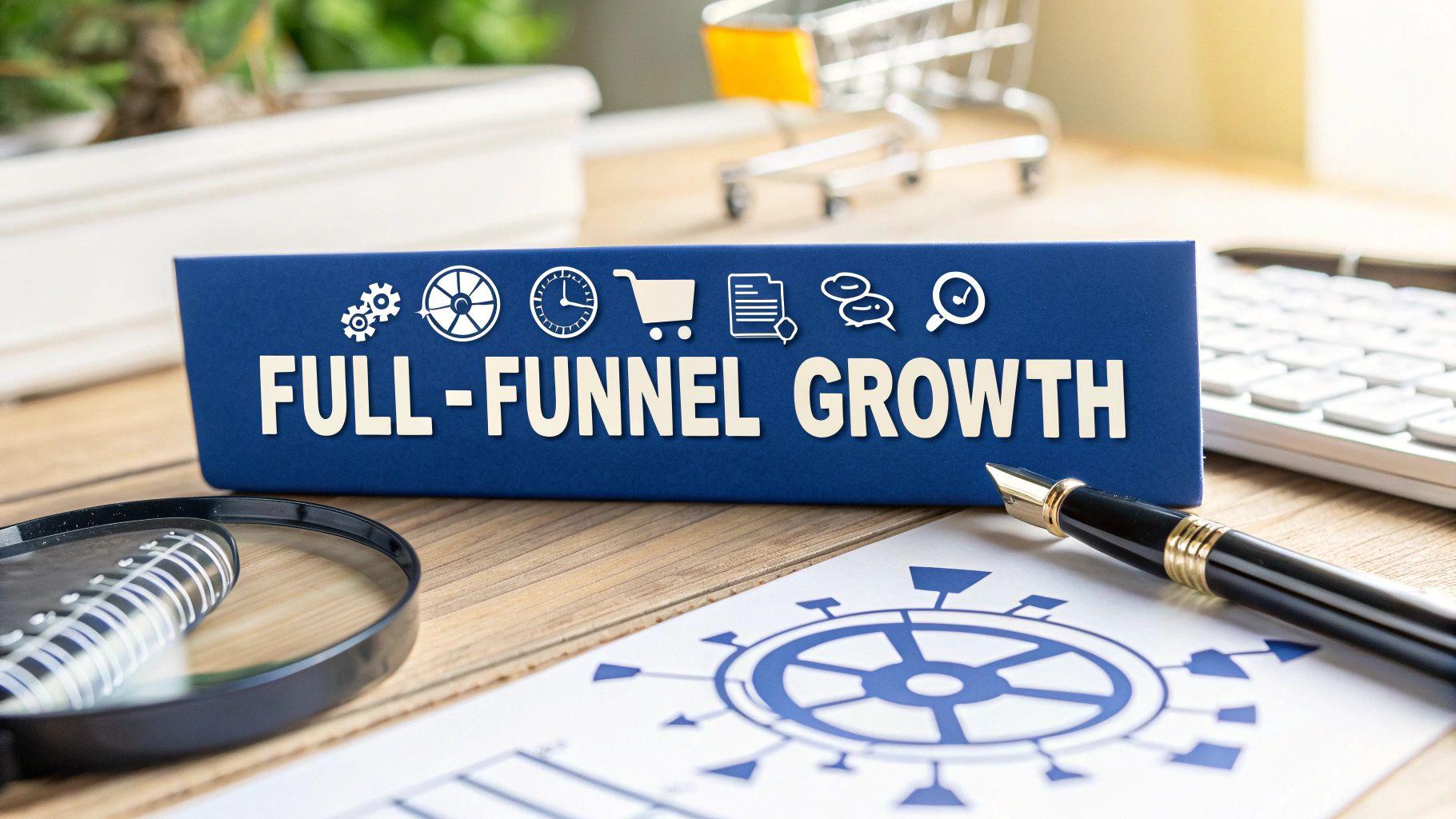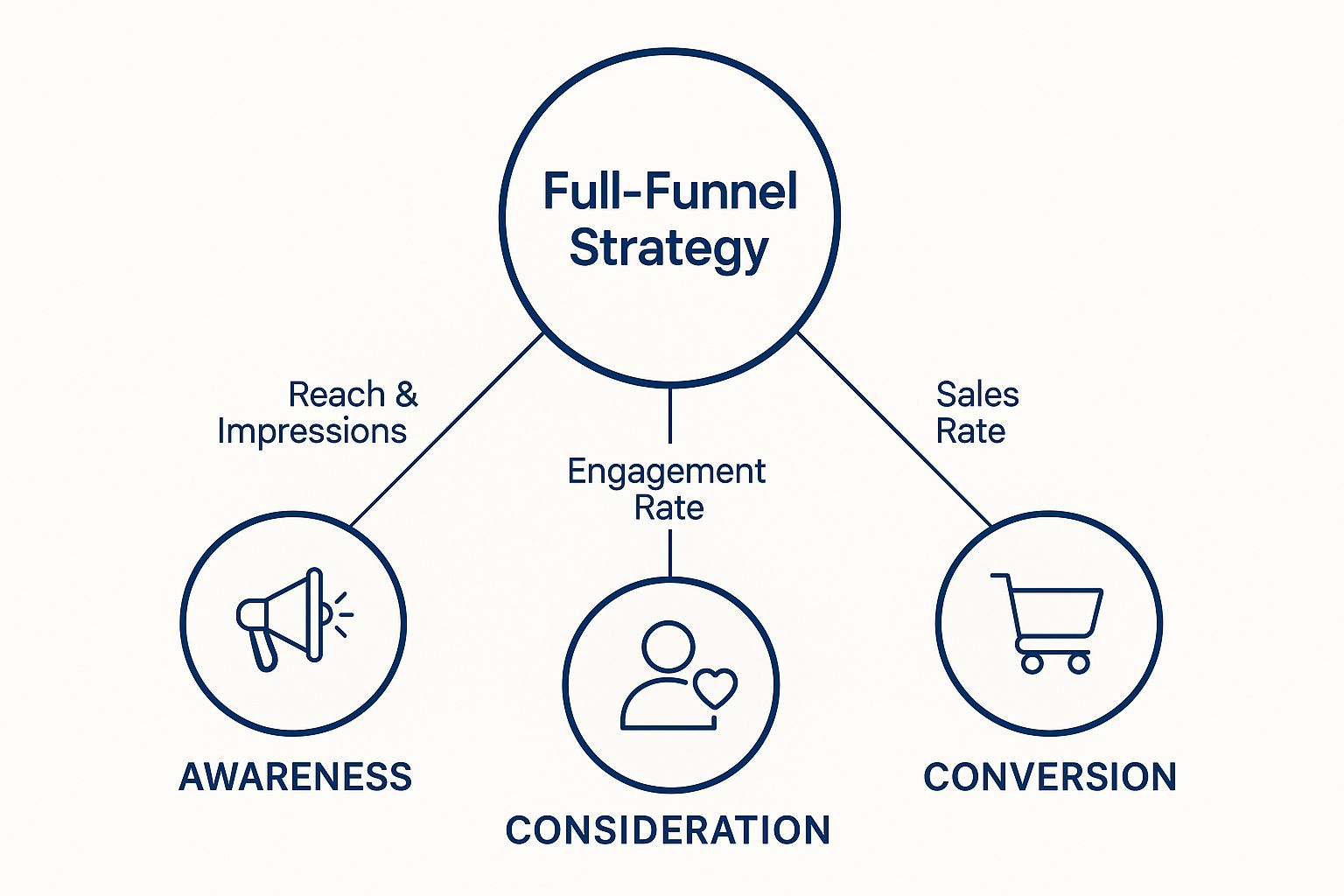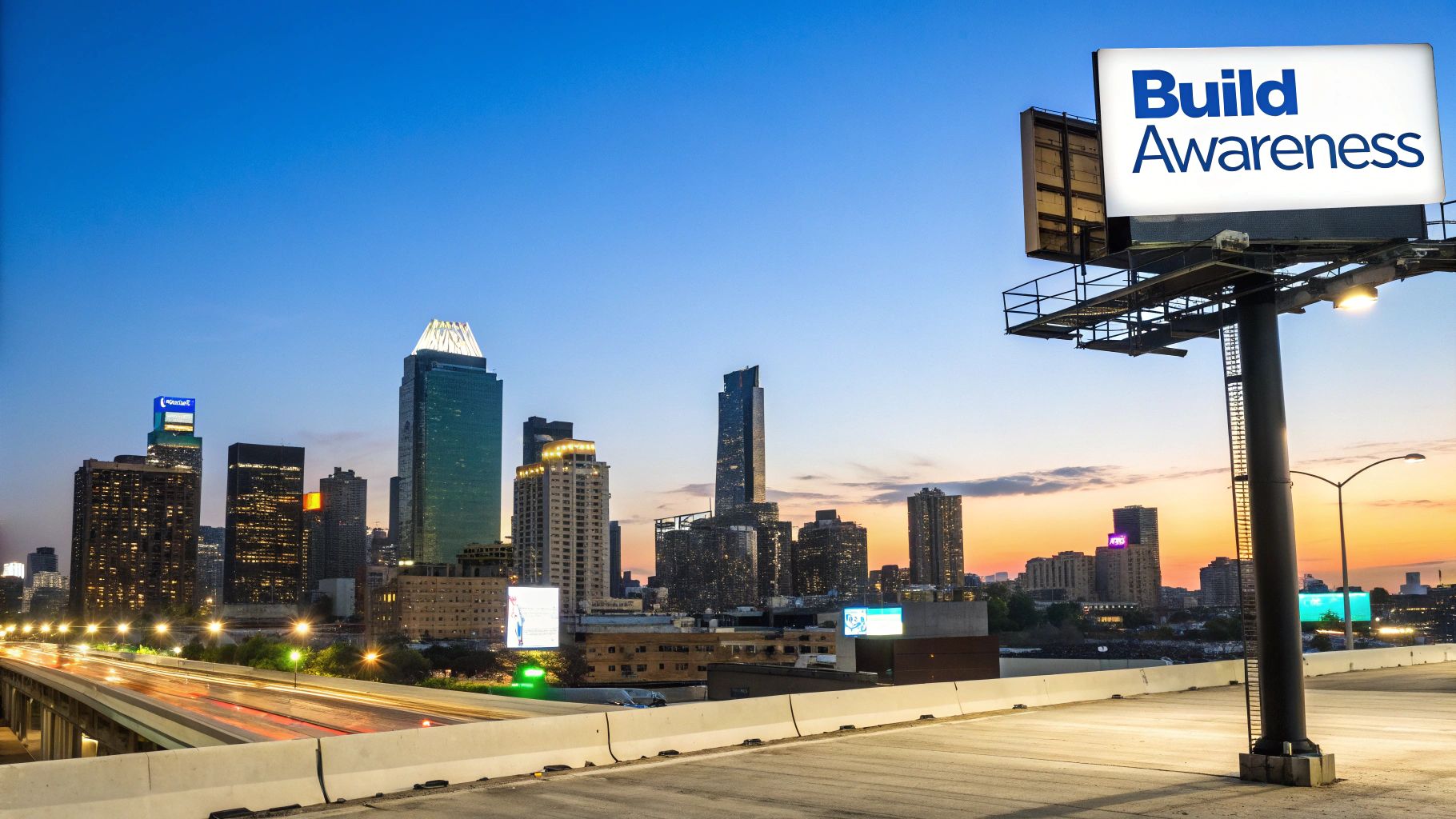A Performance-First Guide to a Full-Funnel Marketing Strategy
Discover how a full-funnel marketing strategy drives conversions from awareness to loyalty. Maximize results and profitability today!

A true full-funnel marketing strategy isn't about running separate campaigns. It's about building a single, coordinated growth engine. Every stage of the customer journey—from initial discovery to repeat purchase—is interconnected, with each investment compounding the next. This is how you stop chasing short-term metrics and start building sustainable, profitable scale.
Rethinking the Silos for Sustainable Growth
For too long, eCommerce leaders have operated in silos. The awareness team chases impressions, the consideration team obsesses over clicks, and the conversion team lives and dies by ACoS. This fragmented approach is a massive drain on budget and potential, creating leaks every time a customer moves between stages.
A performance-first full-funnel strategy dismantles those walls. It operates not as a linear path, but as a flywheel. You build momentum, store it, and reapply it to fuel continuous growth. The goal isn't just to land a single sale; it's to create a self-perpetuating cycle of profitability.
The Flywheel Effect in Action
That investment in a top-of-funnel Amazon DSP campaign doesn't just evaporate after the impression is served. That initial touchpoint is a strategic lever that pays dividends down the line:
- It manufactures future demand. You introduce your brand to high-potential audiences before they even recognize a need, building critical brand recall.
- It powers organic growth. Increased brand awareness from paid media leads to a rise in branded search volume. This is a powerful signal to Amazon's A9 algorithm, directly improving your organic rankings over time.
- It drives down acquisition costs. A shopper who already knows and trusts your brand is far more efficient to convert. Your bottom-funnel Sponsored Products campaigns become more profitable, boosting your total return on ad spend (ROAS).
The core principle is this: stop viewing paid media as a cost center. It is a strategic investment in driving organic growth, enhancing profitability, and capturing sustainable market share. Every dollar spent at the top of the funnel should make your bottom-funnel investment work harder.
This chart illustrates how each stage of a full-funnel strategy—Awareness, Consideration, and Conversion—interconnects to drive specific, performance-oriented goals.

As you can see, a winning strategy isn't about pushing users down a funnel. It's about architecting a system where initial reach translates into qualified engagement, which in turn leads to profitable conversions.
This guide moves beyond generic advice to provide a performance-focused blueprint for executing a full-funnel strategy on Amazon. We will treat PPC and DSP as integrated tools for creating a seamless growth loop, detailing the specific tactics, critical KPIs, and measurement frameworks for each stage.
The takeaway: Stop funding disconnected campaigns. It’s time to build an integrated growth engine where every stage builds momentum for the next, leading to profitable, long-term scale.
Building Your Brand’s Gravity at the Top of the Funnel

This is where sustainable growth begins. The top of the funnel isn't about spraying your brand across the internet and hoping for impressions. It’s about creating a strategic gravitational pull that attracts high-potential audiences—shoppers with a real probability of becoming loyal, high-value customers.
Get this right, and you’re not just generating reach; you’re laying the foundation for long-term profitability.
Think of it this way: every dollar invested at the top must make your mid- and bottom-funnel efforts more efficient. You are warming up an audience and building brand equity before they even think to search for a solution. This front-loaded investment pays dividends by dramatically lowering your customer acquisition costs down the line.
Today's customer journey is non-linear, which is why a full-funnel marketing strategy is non-negotiable. Customers interact with a brand across multiple touchpoints before they even consider a purchase. Research shows that roughly 60% of B2B buyers engage with three to five content pieces before signaling purchase intent, a behavior mirrored in complex B2C sales. This underscores the need to engage them at every step. You can find out more about how demand generation is evolving with these insights on full-funnel success.
Using Amazon DSP to Attract High-Potential Shoppers
While Sponsored Products ads capture existing demand, Amazon DSP (Demand-Side Platform) is your tool for creating new demand. It lets you reach relevant audiences both on and off Amazon before they initiate a product search. This is how you gain a significant competitive advantage.
Instead of targeting keywords, you target audiences. Amazon DSP gives you access to a trove of exclusive first-party data, allowing you to connect with shoppers based on their actual purchase and browsing behaviors.
- In-Market Audiences: Target shoppers Amazon has identified as actively browsing products in your category. A brand selling running shoes can target users who recently viewed running apparel, GPS watches, or competitor product pages.
- Lifestyle Audiences: Target users whose long-term behaviors align with your ideal customer profile. For that same running shoe brand, you could target audiences Amazon identifies as “Marathon Enthusiasts” or those who frequently purchase from health-focused grocery brands via Amazon Fresh.
By using DSP, you’re not just waiting for demand—you’re proactively creating it, filling your funnel with shoppers primed to be interested in your products.
Content That Grabs Attention and Builds Authority
Your ads must be supported by content that provides tangible value. A hard-sell approach at this stage is counterproductive. The objective is discovery and education.
The best top-of-funnel content solves a problem, answers a question, or provides expert insight. You are positioning your brand as an authority, not just another vendor. This builds the foundational trust required to guide a user deeper into the funnel.
This is where brand-relevant, performance-focused content makes all the difference:
- Optimized Blog Posts: Develop articles targeting informational keywords your audience is searching for. If you sell supplements, a post titled "5 Science-Backed Nutrients to Improve Sleep Quality" can capture traffic from users seeking solutions, introducing your brand as a credible resource.
- Engaging Social Media: Use platforms like Instagram or TikTok to share educational videos and how-to guides. A home organization brand, for example, could create short videos demonstrating three ways to organize a pantry, subtly featuring their products in an authentic context.
The Headline Takeaway: The top of the funnel is about strategic audience acquisition, not chasing vanity metrics. Use Amazon DSP to proactively engage high-potential buyers and support those campaigns with value-driven content. This approach builds brand gravity, drives down downstream costs, and expands the pool of qualified customers ready for the next stage.
Nurturing Interest and Building Trust in the Middle of the Funnel

You've made your introduction. Now comes the critical—and often neglected—consideration stage. This is where brands either build on their initial investment or lose the momentum they've generated. Your objective is to prove your value and earn trust.
At this point, shoppers are aware of their problem and know you offer a potential solution. They are now in active research mode: comparing your products to competitors, reading reviews, and weighing their options. A weak mid-funnel strategy is a costly, avoidable mistake.
Industry analyses show that companies with a flimsy mid-funnel see lead-to-customer conversion rates stall below 8%. In contrast, brands with a robust nurturing process often achieve rates of 12-15%. That gap represents a significant amount of squandered ad spend and lost revenue.
Recapture Attention with Precision Retargeting
Your most valuable mid-funnel audience is the group that has already shown interest—they’ve viewed your product detail pages, watched a brand video, or added an item to their cart. Letting them walk away is a cardinal sin in e-commerce. This is where retargeting becomes your most powerful tool.
Amazon provides several ways to re-engage these high-intent shoppers.
- Sponsored Display: This is your primary tool for staying top-of-mind. Create campaigns that specifically retarget users who viewed your products in the last 30 days but did not purchase. Your ads will then follow them as they continue to browse on and off Amazon, serving as a persistent reminder.
- Sponsored Brands Video: Video is unmatched for storytelling. Use this format to retarget shoppers with content that demonstrates your product in action, highlights key differentiators, or features compelling customer testimonials. It’s ideal for building an emotional connection and overcoming purchase hesitations.
The core of mid-funnel success is a critical messaging shift. You’re no longer just saying, "Hey, we exist!" Instead, you're confidently stating, "Here is precisely why we are the best choice for you."
Content That Seals the Deal
While retargeting ads maintain visibility, you need substantive content to back them up. This content gives shoppers the final push of confidence needed to choose you. It is less about the hard sell and more about being the most helpful, trustworthy resource available.
Your content here should directly address the questions and comparisons happening in a shopper's mind. The goal is to make their decision as easy as possible.
What content delivers the best performance?
- In-Depth Product Guides: Go beyond standard bullet points. Use your A+ Content to create a mini-guide that explains the technology behind your product, showcases ideal use cases, or illustrates how it solves a specific, nagging problem.
- Honest Comparison Charts: Don't shy away from comparing your product against competitors or even other models in your own lineup. A clear, visual comparison demonstrates confidence and positions you as a transparent brand, helping shoppers make an informed decision.
- Customer Stories and Testimonials: Nothing builds trust faster than social proof. Feature authentic reviews and video testimonials prominently. For higher-priced items, a concise case study showing how a real customer achieved a specific result can be incredibly persuasive.
Ultimately, a strong mid-funnel strategy directly improves your Marketing Efficiency Ratio (MER) by ensuring your awareness budget isn't wasted. When you actively nurture initial interest, you create a smoother, more profitable path to conversion.
Closing the Deal and Driving Profitability

This is the moment of truth. All the effort invested in building awareness and nurturing interest culminates here: turning high intent into profitable revenue. The bottom of the funnel is where your strategy cashes in. It's all about precision, efficiency, and converting purchase-ready shoppers.
The educational phase is over. You're not persuading; you're facilitating a transaction. The shopper knows what they want and is ready to buy. Your job is to make it frictionless for them to choose you and click "Add to Cart."
This is where a true full-funnel marketing strategy demonstrates its power. Because you’ve already warmed up this audience, shoppers arriving on your product page are familiar with your brand and carry a degree of trust. Your conversion-focused ads don't have to work as hard, leading directly to a healthier bottom line.
Capturing High-Intent Shoppers with Sponsored Products
Your primary tool at this stage is Amazon Sponsored Products. These ads appear directly in shopping results and on product detail pages, capturing users at the exact moment of decision. Profitability here is not about bidding—it's about bidding with surgical precision on the right keywords.
Your targeting must be laser-focused on terms that signal immediate purchase intent.
- Branded Keywords: This is non-negotiable. Bidding on your own brand and product names protects your digital shelf space from competitors and captures sales from users actively seeking you out. It is your most efficient source of conversions.
- Long-Tail Keywords: These are specific, multi-word phrases like "silent mechanical keyboard for gaming" instead of just "keyboard." They carry lower search volume but significantly higher intent, which translates to better conversion rates and a lower Advertising Cost of Sale (ACoS).
A well-managed Sponsored Products strategy does more than drive immediate sales. It sends powerful positive signals to Amazon's A9 algorithm. Each conversion reinforces to Amazon that your product is a relevant result for those keywords, which helps elevate your organic ranking over time. The flywheel in action: paid ads directly fuel organic growth.
Rescuing Sales with DSP Retargeting
Even high-intent shoppers get distracted. Carts are abandoned. On Amazon, a staggering 75% of shoppers abandon their carts before checkout. Allowing that potential revenue to walk away is a massive strategic error.
This is where Amazon DSP becomes your secret weapon for closing the loop. It enables you to launch highly specific retargeting campaigns aimed squarely at this high-value audience.
An abandoned cart is not a loss; it is an opportunity. A DSP campaign targeting users who added your product to their cart in the last 7 days is one of the highest-return activities you can run. You are simply reminding an almost-customer to complete their purchase.
This tactic isn't just about recovering a single sale. It’s about maximizing the ROI of the ad spend that got the shopper to the cart in the first place.
Real-World Performance: The Coffee Brand Case Study
Consider a premium coffee bean brand on Amazon. They observed a climbing ACoS and flattening sales. They executed a bottom-funnel overhaul based on performance data:
- Keyword Audit: They analyzed their Search Query Performance report, finding that broad keywords like "coffee" were burning budget with minimal conversions. They paused these and reallocated the funds.
- Strategic Bidding: They increased bids on their branded terms ("Velo Coffee") and on high-performing long-tail keywords like "fair trade whole bean espresso" and "low acid dark roast coffee," which consistently converted at a high rate.
- DSP Retargeting: They launched a DSP campaign targeting only users who had added their coffee to a cart in the past 7 days but hadn't purchased. The ad was simple, featuring their five-star rating and a "Complete Your Order" call-to-action.
Within 60 days, their ACoS dropped by 30%, and total sales increased by 15%. Critically, their organic rank for their most profitable keywords climbed into the top three positions. Their paid strategy didn't just drive sales—it directly improved their organic visibility and overall profitability.
The Headline Takeaway: The bottom of the funnel is about converting intent into profit as efficiently as possible. Master Sponsored Products by focusing on branded and long-tail keywords, then use DSP to reclaim abandoned carts. This direct, performance-focused approach secures sales, improves your organic standing, and builds a more sustainable Amazon business.
Creating Your Untapped Retention and Advocacy Loop
Too many brands view the sale as the finish line. In reality, it’s the starting point of the most profitable phase of the customer relationship. If your entire budget is focused on acquiring new customers, you are ignoring a goldmine: your existing customer base.
This is where your strategy evolves from a linear funnel into a powerful, self-sustaining growth loop. A purchase is an invitation to turn a one-time buyer into a loyalist, and ultimately, a brand advocate. This is when the flywheel truly gains speed, as satisfied customers generate the social proof that pulls the next wave of shoppers into the top of your funnel.
Fostering Loyalty and Driving Repeat Purchases
Let's be blunt: retaining a customer is exponentially cheaper and more profitable than acquiring a new one. The data is unequivocal. On Amazon, you have powerful tools to embed loyalty directly into your sales process.
- Amazon Subscribe & Save: For any consumable product, this is non-negotiable. Offering a small discount for recurring deliveries does more than lock in future revenue; it takes your brand out of the competitive consideration set. Once a customer subscribes, they are no longer browsing alternatives each month—you have secured their loyalty.
- DSP Retargeting for Cross-Sells: Think beyond cart abandonment. Use Amazon DSP to build audiences of past purchasers. Did a customer buy your premium skincare serum last month? Now, serve them ads for your complementary moisturizer or eye cream. You are presenting relevant products to a warm audience that has already demonstrated trust in your brand.
The key metric here is Customer Lifetime Value (CLV). A single customer who purchases five times is infinitely more valuable than five customers who each purchase once. Focusing on this retention loop builds a more predictable and profitable business.
Turning Customers into Your Best Marketers
Advocacy is the ultimate goal. When a customer leaves a positive review or recommends your product, they are creating high-impact marketing assets for you—at no cost. This social proof is incredibly powerful and directly influences the conversion rates of new shoppers.
This is why your post-purchase communication strategy is critical. A simple, well-timed email can prompt a customer to leave a review. That review strengthens your product detail page, which in turn sends positive signals to Amazon’s algorithm. This is the full-funnel loop in action: an action at the very end of the journey directly fuels success at the very beginning.
Higher review counts and ratings make your product more compelling to new shoppers. For brands serious about scale, mastering this advocacy loop is a game-changer, just as it was when we helped a lifestyle brand double its market share by implementing a truly holistic strategy.
The Headline Takeaway: Your funnel doesn't end at the purchase. Actively build a retention and advocacy loop. Use tools like Subscribe & Save and strategic DSP retargeting to grow CLV. Then, nurture those customers post-purchase to generate the reviews and social proof that will fuel a powerful, self-feeding cycle of long-term growth.
Measuring What Matters with Full-Funnel Attribution
You can’t optimize what you can’t measure. For a full-funnel marketing strategy, legacy measurement models are a recipe for flawed decision-making. Attributing 100% of the credit to the last click before a sale is dangerously myopic. It tells you who scored the goal but ignores the teamwork that advanced the ball down the field.
Relying solely on last-click attribution is like praising the striker while firing the midfielders whose assists made the shot possible. This flawed perspective leads brands to slash budgets for the very awareness and consideration campaigns that warm up audiences and make final conversions more efficient.
Shifting to a Holistic Measurement Mindset
A true full-funnel approach requires a comprehensive view of the entire customer journey. You must connect the investment at the top of the funnel to the revenue generated at the bottom. This is where tools designed for modern marketing, like Amazon Attribution, become essential.
Amazon Attribution allows you to measure how your off-Amazon marketing efforts—like a Facebook ad, an influencer post, or a Google Search ad—directly contribute to sales on Amazon. It provides clear line-of-sight, proving how upper-funnel DSP campaigns are doing more than generating impressions; they are actively driving purchases. For a deeper look at putting these tools to work, check out our complete guide on Amazon advertising attribution.
The objective is to move beyond obsessing over isolated metrics like ACoS for a single campaign. Instead, you must analyze marketing performance through the lens of total business impact, measuring the complete path to purchase. This gives you the data-backed confidence to fund channels that build momentum, not just those that harvest existing demand.
This shift is now the standard for performance-driven marketers. Data shows that brands adopting full-funnel attribution can increase their marketing ROI by 15-25%. They achieve this by reallocating budgets to the channels that effectively nurture customers throughout the entire journey, not just those capturing the final click. You can see more on how data is changing modern marketing and driving this evolution.
The Headline Takeaway: Stop making budget decisions with one eye closed. By adopting a holistic attribution model, you can understand the true value of each touchpoint. When you connect upper-funnel investments to bottom-line results, you can invest with confidence, build a truly profitable marketing engine, and drive sustainable growth.
Your Full-Funnel Marketing Questions Answered
We understand that transitioning from siloed campaigns to a true full-funnel marketing strategy is a significant operational shift. To provide clarity, here are no-nonsense answers to the questions we hear most from eCommerce leaders.
How Should I Allocate My Budget Across the Funnel?
There is no universal magic formula, but a solid starting point for an established brand is the 40-30-30 split: 40% to top-of-funnel awareness (e.g., DSP prospecting), 30% to mid-funnel consideration (e.g., retargeting), and 30% to bottom-funnel conversion (e.g., Sponsored Products).
For a new brand launch, this must be more aggressive at the top, potentially allocating 60% or more of the budget to build initial awareness. The key is agility. Continuously monitor performance using tools like Amazon Attribution to understand what's driving results and reallocate spend accordingly.
How Do Paid Ads and Organic Performance Really Connect?
They are two sides of the same coin, and PPC is a powerful lever for organic growth. A strategic paid advertising program doesn't just drive sales today; it directly fuels organic performance tomorrow.
Every conversion from a Sponsored Products ad sends a strong relevancy signal to Amazon's A9 algorithm. It tells Amazon your product is a preferred choice for specific keywords, which helps elevate your organic ranking for those same terms. View your ad spend as an investment in both immediate revenue and long-term organic real estate.
What Is the Easiest Way to Get Started?
Start at the bottom of the funnel and build upward. This is the most logical and capital-efficient approach.
- Secure the Bottom: Master your Sponsored Products campaigns for branded terms and high-intent, long-tail keywords. This captures existing demand, protects your brand from competitors, and establishes a profitable foundation.
- Add Mid-Funnel Retargeting: Implement Sponsored Display campaigns to re-engage users who visited your product pages but did not convert. This is a simple, high-return tactic to bring qualified traffic back.
- Expand to the Top: Once your conversion engine is optimized and profitable, begin investing in top-of-funnel DSP campaigns to proactively find new audiences and fill the top of your funnel.
This phased approach ensures you are building on a solid, profitable base from day one.
Ready to stop guessing and start building a profitable, data-driven growth engine on Amazon? Headline Marketing Agency specializes in creating integrated PPC and DSP strategies that drive real business results. Let's build your brand's growth strategy together.
Ready to Transform Your Amazon PPC Performance?
Get a comprehensive audit of your Amazon PPC campaigns and discover untapped growth opportunities.